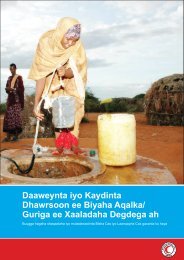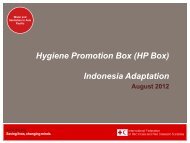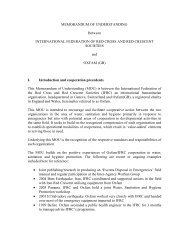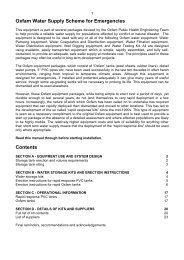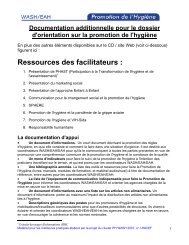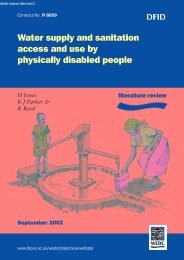Hygiene Promotion - IRC International Water and Sanitation Centre
Hygiene Promotion - IRC International Water and Sanitation Centre
Hygiene Promotion - IRC International Water and Sanitation Centre
Create successful ePaper yourself
Turn your PDF publications into a flip-book with our unique Google optimized e-Paper software.
• The costs of inaction can be high. Peru’s 1991 cholera epidemic is estimated to havecost the national economy an amount equal to US$ 200 million (Bradford <strong>and</strong> Suarez,1993). It would have been cheaper to provide the clean water supplies, improvedsanitation <strong>and</strong> hygiene promotion that would have prevented the epidemic <strong>and</strong>assisted socio-economic development. There are similar examples from India.Outbreaks of plague in 1994 meant a loss of two billion dollars due to importrestrictions. On top of that came the loss from thous<strong>and</strong>s of cancelled holidays <strong>and</strong>public health costs (De Volkskrant, 22 October 1994).• At the household level too, hygiene-related diseases bring unnecessarily highexpenditure. Suffering from diarrhoeas, eye infection <strong>and</strong> skin diseases (all threehygiene related) meant an aggregated cost of US$ 10-11 per person per year for ruralhouseholds in Uttar Pradesh, India (Verma & Srivastava, 1990). Investing in hygienepromotion to prevent such outbreaks <strong>and</strong> reduce regular disease is highly costeffective(Varley & Bendahmane, 1997). When hygiene promotion is combined withaccess to improved water supply <strong>and</strong> sanitation, the estimated cost is only US$ 3 perhousehold per year for each averted case of diarrhoea in children under five. When nowater <strong>and</strong> sanitation facilities are provided, the cost of promoting good hygiene isobviously higher. However, it costs only US$ 6 per household per year to keep a childfree from diarrhoea when hygiene is improved without the costs of hardware.Quite separately from the economic <strong>and</strong> health arguments, there is a powerful moralimperative to improve hygiene conditions in poor communities. The affront to hum<strong>and</strong>ignity of open defecation in squalid stinking home environments is a blight on modernsociety that shames everyone concerned. The satisfaction of being able to restore dignity<strong>and</strong> self-respect through simple interventions is an energising reward for the hygienepromoter. See: <strong>Water</strong> is life ... sanitation is dignity (Sir Richard Jolly, former chairperson ofthe <strong>Water</strong> Supply <strong>and</strong> <strong>Sanitation</strong> Collaborative Council (WSSCC),http://www.wsscc.org/about/ccnews.php?id=41. See also: Can anyone hear us? Voices ofthe poor http://www.worldbank.org/poverty/voices/index.htmS<strong>and</strong>y Cairncross <strong>and</strong> Valerie Curtis of the London School of <strong>Hygiene</strong> <strong>and</strong> TropicalMedicine (LSHTM) offer more arguments for promoting hygiene <strong>and</strong> sanitation (seeAppendix 5) in a paper presented at the World Bank <strong>Water</strong> Forum in 2001 <strong>and</strong> reprinted onthe WSSCC website.Health benefits from improved sanitation, hygiene <strong>and</strong> water supply:1. Improved sanitation;• 36% reduction in incidence of diarrhoeas from improved excreta disposal;• 30% reduction in incidence of diarrhoeas in children (3-36 months) in households withflush toilets;• 15% in incidence of diarrhoeas in children (3-36 months) in households with pitlatrines;• 40% reduction of children with stunted growth in households with flush toilets;<strong>IRC</strong> <strong>International</strong> <strong>Water</strong> <strong>and</strong> <strong>Sanitation</strong> <strong>Centre</strong> 9



